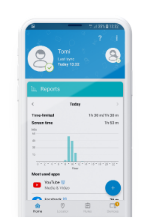Securing your kid's tech for the modern classroom
Prepare for the upcoming school year
Managing family screen time is more challenging than ever, so here are five ways to help you find the right balance.
Pay attention to what your kids are watching and doing on their devices and monitor their reactions during and after screen time. Age-appropriate and interactive content should have positive, not negative, effects on their behavior. If they’re crying, angry or aggressive after an online game or a cartoon, take the time to find out why.
Exploring online content together—for example, discussing a movie and possible ways it might have ended differently—can be an enriching experience and provide learning opportunities for both of you.
Revisit your daily routine and set guidelines with help from technology. Parental control apps can help not only create a safe online experience, but also let you set limits. For example, for Android allows you to limit their online and gaming time and block websites with inappropriate content. It also gives a voice to kids by letting them ask you for permission to play or browse longer on specific websites.
You can also create a written “digital contract” with input from the family that outlines the amount of time everyone can spend online. That should include you, the parent. Committing to taking a break from work at a certain time each day to spend time with the family sets a great example for everyone.
Having the technical skills to use digital devices doesn’t automatically mean children know how to use them responsibly. It’s important to discuss how the web differs from real life; for example, someone who uses a photo of a little boy in their profile might actually be a grownup. This is also a good time to calmly explain safety tips, like not responding to a stranger’s request for your address or a picture.
Sharing time online with your kids lets you expose them to content that is meaningful, funny, or stimulates their creativity. You can show them how the web provides tools for learning and exploring. For example, have your child name a state or a country. Then find it on a map, view photos, learn about its history, etc.
It’s important to take a step away from the screen, for both children and parents. As a parent, you can choose non-technological ways to connect and meet the needs of the whole family. Including children in meal preparation or selecting groceries online, reading a story together or scheduling daily family walks are great ways to break up the routine.
It’s been proven that if children have rich personal resources (such as books, educational toys, hobbies, etc.) and plenty of positive interactions with family members, screen time doesn’t correlate significantly with online addiction. In these unprecedented times, some days will be easier than others so stay calm and remember to give yourself a break too.


With ESET Parental Control for Android
Try free for 30 daysPrepare for the upcoming school year
The risk of cyberattack in distance learning is significant
Teachers around the world are adapting to the “new normal” of remote teaching. And while some schools are beginning to open back up, teachers and parents should still be thinking about how to stay connected with classrooms from a distance.